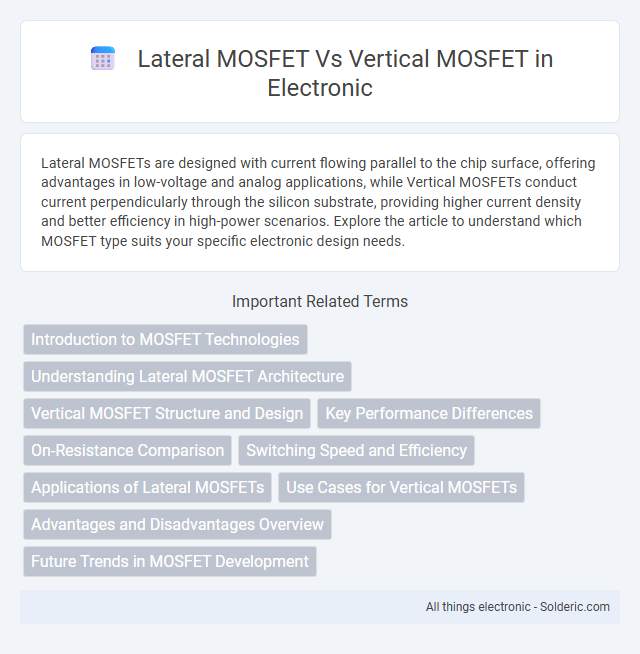Lateral MOSFETs are designed with current flowing parallel to the chip surface, offering advantages in low-voltage and analog applications, while Vertical MOSFETs conduct current perpendicularly through the silicon substrate, providing higher current density and better efficiency in high-power scenarios. Explore the article to understand which MOSFET type suits your specific electronic design needs.
Comparison Table
| Feature | Lateral MOSFET | Vertical MOSFET |
|---|---|---|
| Current Flow Direction | Parallel to the wafer surface | Perpendicular to the wafer surface |
| Device Structure | Planar, with source and drain on the same surface | Stacked, with current flowing vertically through the substrate |
| On-Resistance (RDS(on)) | Generally higher due to limited channel width | Lower due to larger current conduction area |
| Voltage Rating | Typically lower voltage applications | Higher voltage capability |
| Switching Speed | Faster switching, suitable for RF and analog circuits | Moderate switching speed, optimized for power applications |
| Power Dissipation | Higher due to larger resistance and lateral current path | Lower, more efficient heat dissipation |
| Application | Low power, RF devices, integrated circuits | Power electronics, high current and voltage handling |
| Manufacturing Complexity | Simpler fabrication process | More complex due to 3D structure |
Introduction to MOSFET Technologies
Lateral MOSFETs feature channel current flow parallel to the semiconductor surface, optimizing compactness in integrated circuits and high-frequency applications. Vertical MOSFETs conduct current perpendicular through the substrate, enabling higher current capacity and lower on-resistance crucial for power electronics. Different structural configurations impact switching efficiency, thermal management, and scalability in semiconductor device design.
Understanding Lateral MOSFET Architecture
Lateral MOSFET architecture features source, drain, and gate electrodes arranged on the same surface plane, enabling straightforward integration with standard CMOS processes and allowing efficient control of channel conduction. This planar structure offers advantages in low-voltage applications and ease of fabrication but typically exhibits higher on-resistance compared to vertical MOSFETs, which use a vertical current flow path for better handling of high currents. Understanding your application's current density and voltage requirements helps determine if lateral MOSFETs provide the optimal balance of performance and manufacturing simplicity.
Vertical MOSFET Structure and Design
Vertical MOSFETs feature a current flow that moves vertically from the source at the top to the drain at the bottom, allowing for a smaller chip area and higher current density compared to lateral MOSFETs. The design includes a vertically stacked gate, channel, and drift region, enabling efficient heat dissipation and lower on-resistance, which is crucial for power semiconductor applications. Your choice of a vertical MOSFET structure enhances overall device performance, especially in high-voltage and high-current scenarios due to its optimized vertical conduction path.
Key Performance Differences
Lateral MOSFETs typically exhibit lower breakdown voltages and higher on-resistances compared to Vertical MOSFETs, making them more suitable for low-voltage, high-frequency applications. Vertical MOSFETs offer superior current handling capabilities and lower conduction losses due to their vertical current flow path and larger effective channel width. Your choice between lateral and vertical MOSFETs should consider these key performance differences to optimize efficiency and reliability in your specific electronic designs.
On-Resistance Comparison
Lateral MOSFETs typically exhibit higher on-resistance due to their horizontal current flow path and smaller cross-sectional area for conduction, affecting overall efficiency. Vertical MOSFETs feature lower on-resistance because their current flows vertically through the entire wafer thickness, allowing greater current capacity and reduced power loss. Your choice between these devices will impact device performance, especially in applications requiring minimal conduction loss and high power efficiency.
Switching Speed and Efficiency
Lateral MOSFETs typically offer faster switching speeds due to their planar structure, which reduces parasitic capacitances and allows quicker charge movement, enhancing overall efficiency in high-frequency applications. Vertical MOSFETs, on the other hand, excel in handling higher currents with lower on-resistance, but their bulkier design can limit switching speed and efficiency in fast-switching scenarios. Understanding these differences helps you select the optimal MOSFET type for your power electronics design to balance speed and efficiency requirements effectively.
Applications of Lateral MOSFETs
Lateral MOSFETs are predominantly used in low-voltage analog and mixed-signal circuits due to their ease of integration with standard CMOS processes and superior electrostatic discharge (ESD) robustness. They find applications in power management ICs, RF amplifiers, and sensor interfaces where compact layout and high-frequency performance are crucial. Their planar structure enables efficient on-chip integration, making them ideal for battery-powered devices and portable electronics.
Use Cases for Vertical MOSFETs
Vertical MOSFETs are commonly used in high-power applications such as power supplies, motor drives, and DC-DC converters due to their superior current handling and lower on-resistance. Their vertical structure allows efficient heat dissipation and higher voltage operation, making them ideal for automotive and industrial environments. You benefit from improved efficiency and reliability in demanding power management scenarios by choosing vertical MOSFETs over lateral types.
Advantages and Disadvantages Overview
Lateral MOSFETs offer easier integration with standard IC processes, enabling compact designs and efficient switching in low-voltage applications. Vertical MOSFETs provide higher current capacity and better heat dissipation due to their vertical conduction path, making them suitable for power electronics and high-voltage scenarios. Your choice between the two depends on balancing size, power handling, and thermal performance requirements.
Future Trends in MOSFET Development
Future trends in MOSFET development emphasize improved energy efficiency and miniaturization, with vertical MOSFETs gaining prominence due to their superior current handling and smaller footprint. Lateral MOSFETs continue evolving with enhanced surface mobility through advanced materials like GaN and SiC, targeting high-frequency and low-voltage applications. You can expect a convergence of these technologies in next-generation power electronics, driven by demands for faster switching speeds and reduced power loss.
Lateral MOSFET vs Vertical MOSFET Infographic

 solderic.com
solderic.com